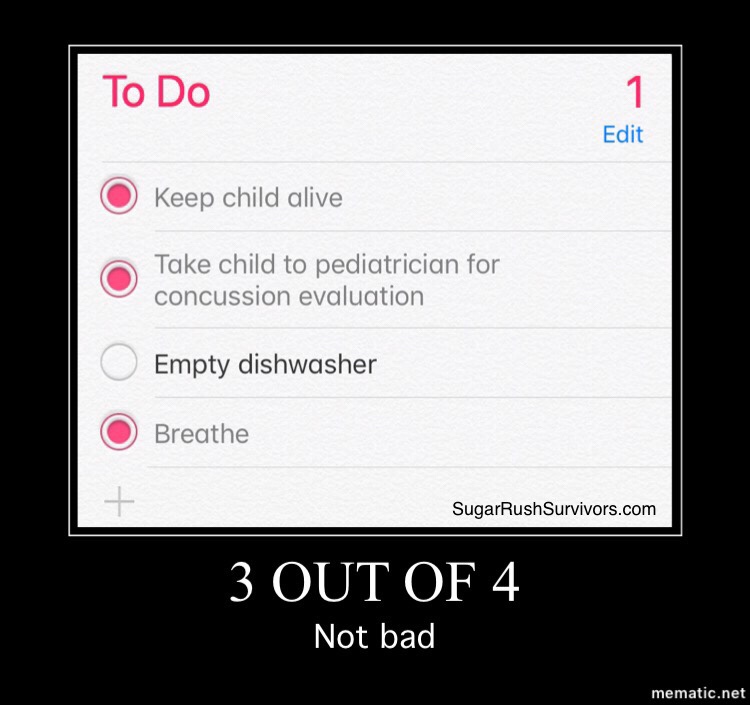Struggling. That’s what the mom right before me in line to check in late to school had written in the “reason” column. The mom who signed “struggling” had already left by the time I was signing in, but I thought, “Aww, I want to give her a hug and be her friend.” I also cracked up laughing. I love the honesty of it. I might get that embroidered on a shirt. “Struggling” in a nice, innocuous, tidy script font on the breast pocket of a tidy shirt.
We all have days when we struggle. Sometimes those days turn into weeks and months. When that happens, it is time to reach out for support. Find your support. As Rebekah Rap likes to say on T1D Mod Squad, “Find your tribe and love them hard.” Support makes all the difference and comes in varying degrees. What has made the biggest difference for me is just knowing I am not alone in my struggles. It doesn’t remove what I’m dealing with at the moment, but it certainly changes my attitude and makes it easier for me to keep calm and carry on.
The morning of the struggling sign in, I had put an insulin infusion site on my son before school. The process is much improved from our early days. When he was first diagnosed with type 1 diabetes at the age of 21 months old, he used syringes and we had to inject him with insulin at least 6 times a day and more if he wanted an extra snack. Seven months after diagnosis he got a pump. He was two years old then and I had to physically restrain him with my body while also trying to correctly inject a cannula just under the skin of his tummy or thigh. It was like trying to pin down an angry octopus for a tentacle piercing. Every three days. The angry octopus learned quickly and got wily. He would hide. Barter. Beg. It ended in tears and screaming for both of us. My husband was highly involved (thank goodness) and in those early days, he was my go-to for putting on sites. My job was to hold the squirming, crying, frantic toddler. But there were plenty of times when I had to do it myself or call on our sweet neighbor Ashley to help. Thank the Lord for compassionate friends and neighbors. And I eventually adapted so that I could do them myself with less drama, less struggling for all involved.
Now at age 6, we have streamlined the process with input from the boy himself. We put on numbing cream, wait at least 15 minutes, wash it off, wipe the area with rubbing alcohol, and wait 2 minutes for it to dry completely. Just before we apply a new site, my son chooses a number of deep breaths to take. He’s done as few as 6 and as many as 23. I do the deep breathing with him. The day he chose 23 we were both feeling pretty mellow by the end! After the deep breaths, he spreads his feet out to brace himself and tells me, “Readyyyyyy… seeeeet…. gooo…” in a shaky voice. I squeeze the spring-loaded applicator that shoots the needle and cannula into his skin. I count 10 seconds and then pull the needle out, leaving the cannula in place. He gets one Nerd or one Jelly Belly for holding still during site changes. So, all of that to say, while this particular morning’s insulin infusion site change wasn’t as traumatic as it has been for us in the past, it still took up a chunk of time and was an extra hurdle for us. Add in two knocks to the head in one week with trips to the pediatrician for concussion evaluations and yeah… I have an active 6-year-old boy. I’m struggling. But I’m here. And so is he.

A major turning point for me was meeting my co-blogger Alese and having someone to talk with in person who understood the language of T1D. I asked her on a recent random Tuesday what her mental To Do list looked like.

In the spirit of support, I am preparing a new page on my site for resources and I will add to it as I am able. Know that whatever you are dealing with in this moment, you are not alone. Reach out. Find people who have been where you are. We are here with you and we can help.
Type 1 diabetes has no cure, is not caused by diet, is an autoimmune disease, and can develop at any age. Symptoms can appear suddenly and are often mistaken for flu, strep, and/or urinary tract infections. Symptoms may include:
— Increased thirst
— Frequent urination
— Weight loss (or in children, failure to gain)
— Extreme hunger
— Fatigue, lethargy
— Irritability or mood swings
— Blurry vision
— Yeast infection
— Odd smelling breath or urine (sweet, fruity, or like acetone)
— Heavy or labored breathing
— Nausea or vomiting
Erin Turnham lives in Montgomery and blogs about life as the mother of a child with Type 1 Diabetes at Sugar Rush Survivors.












